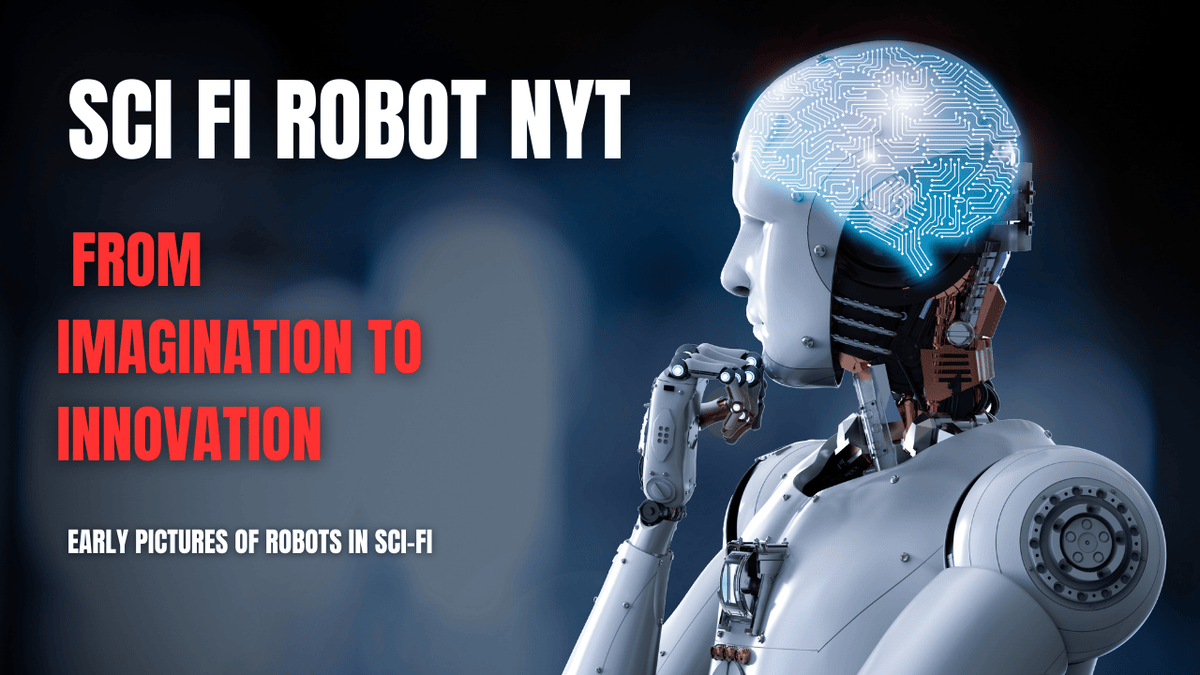Introduction: sci fi robot nyt and Their New York Times Connection
The New York Times has long been a beacon of high-quality journalism, and its coverage of futuristic topics like sci-fi robots is no exception. From speculative fiction to real-world advancements, the Times has explored how robots could shape our future in various intriguing ways. Sci-fi robots, with their dazzling technology and often dystopian narratives, capture our imagination and reflect our hopes and fears about the future. This article delves into the portrayal of sci-fi robots in The New York Times, analyzing their impact, how they mirror societal concerns, and what they reveal about the evolving landscape of robotics.
Sci-Fi Robots in Popular Culture: A New York Times Perspective
The New York Times has consistently featured sci-fi robots in both its entertainment and technology sections. These robots often symbolize humanity’s greatest ambitions and deepest anxieties, offering a lens through which we can examine our evolving relationship with technology. In the realm of popular culture, sci-fi robots are not just figments of imagination; they represent real-world technological dreams and challenges.
One prominent example is the Times’ coverage of films like “Blade Runner” and “Ex Machina,” which explore themes of artificial intelligence and human-robot interaction. These films, often reviewed in the Times, provide a window into how our culture perceives robotics and AI. The robots in these movies are more than just mechanical beings; they embody philosophical questions about consciousness, identity, and ethics. The New York Times critiques and analyses help readers navigate these complex themes, offering insights into how these fictional narratives intersect with real-world technological advancements.
Additionally, the Times frequently examines the influence of sci fi robot nyt on popular media and consumer technology. From the whimsical robots of “The Jetsons” to the more sinister creations in “Black Mirror,” these portrayals reflect both optimistic and cautionary perspectives on technological progress. The newspaper’s coverage of these representations not only informs readers about current trends but also encourages critical thinking about the implications of robotics and AI.

The Real Science Behind sci fi robot nyt: What The New York Times Reveals
While sci fi robot nyt often venture into the realm of imagination, the New York Times provides a bridge between these fictional creations and real-world technology. The newspaper’s science and technology sections frequently explore how current innovations in robotics are beginning to mirror the fantastical robots of science fiction.
For instance, advancements in artificial intelligence and machine learning have led to robots that can perform increasingly complex tasks. The New York Times reports on breakthroughs in robot design and functionality, showcasing how engineers are turning sci fi robot nyts into reality. Articles detailing the development of robots with advanced sensory capabilities or the integration of AI for autonomous decision-making highlight the growing convergence between fiction and reality.
Moreover, the Times also addresses the ethical and societal implications of these advancements. As robots become more sophisticated, questions about their impact on employment, privacy, and human relationships become more pressing. The newspaper’s in-depth reporting on these issues helps readers understand the broader context of robotic innovation and its potential consequences for society.
Ethical Considerations: The New York Times on Robot Rights and Morality
One of the most intriguing aspects of the New York Times’ coverage of sci fi robot nyt is its exploration of ethical considerations. The newspaper frequently delves into discussions about robot rights and the moral dilemmas posed by advanced robotics and AI. These conversations are crucial as technology evolves and robots become increasingly integrated into our daily lives sci fi robot nyt.
The ethical questions surrounding robots often stem from their portrayal in science fiction. For example, the Times has featured articles analyzing the moral implications of robots with human-like characteristics and consciousness. These discussions include debates about whether robots should have rights or be considered sentient beings. By examining these issues, the New York Times helps readers grapple with the potential ethical challenges of future robotics.
Furthermore, the Times covers the impact of robots on human relationships and societal norms. As robots take on roles traditionally filled by humans, such as caregiving or companionship, questions arise about their role in our lives and the potential for emotional attachment. The newspaper’s reporting on these topics encourages a nuanced understanding of how robots might affect human interactions and societal structures sci fi robot nyt.
The Future of Robotics: Predictions and Speculations in The New York Times
The New York Times often features speculative articles that predict the future of robotics and AI. These pieces blend expert opinions, scientific research, and imaginative projections to provide a glimpse into what might lie ahead. The newspaper’s forward-looking coverage helps readers anticipate how advancements in robotics could reshape various aspects of life.
Predictions of robotics range from the development of humanoid robots with advanced emotional intelligence to the integration of robotics into everyday tasks like cooking and cleaning. The Times’ articles on these topics offer a mix of optimism and caution, highlighting both the potential benefits and challenges of emerging technologies.
In addition to technological advancements, the Times also explores how robots might influence different industries, from healthcare to entertainment. For example, the newspaper has reported on the potential for robots to assist in medical procedures or provide personalized customer service. These predictions provide valuable insights into how robotics could transform various sectors and impact our daily lives sci fi robot nyt.
Societal Impact: How sci fi robot nyt in The New York Times Reflect Public Sentiment
The portrayal of sci fi robot nyt in The New York Times reflects broader societal sentiments about technology and progress. Through its coverage, the newspaper captures public concerns, hopes, and fears about the role of robots in our future.
Articles that discuss the societal impact of robots often address themes like job displacement, privacy concerns, and the potential for increased surveillance. By highlighting these issues, the Times provides a platform for public discourse and helps readers understand the broader implications of robotics and AI.
Moreover, the newspaper’s coverage of public reactions to robots and AI innovations offers insights into how different communities perceive these technologies. From enthusiastic adopters to cautious skeptics, the diverse range of opinions reflected in the Times’ reporting illustrates the complex relationship between society and technology sci fi robot nyt.
Challenges and Controversies: The New York Times on Robot Failures and Ethical Dilemmas
Despite the excitement surrounding advancements in robotics, the New York Times also addresses the challenges and controversies associated with these technologies. From technical failures to ethical dilemmas, the newspaper provides a balanced view of the hurdles that come with developing and deploying robots.
One notable area of coverage is the technical challenges faced by robotic engineers. The Times reports on instances where robots have malfunctioned or failed to perform as expected, shedding light on the difficulties of creating reliable and efficient robots. These articles highlight the ongoing efforts to overcome technical obstacles and improve robotic systems.
Additionally, the Times explores ethical controversies related to robotics, such as the use of robots in warfare or surveillance. These discussions raise important questions about the responsible use of technology and the potential consequences of deploying robots in sensitive areas. By addressing these controversies, the New York Times encourages critical examination of the ethical implications of robotics.
The New York Times’ Role in Shaping Public Perception of sci fi robot nyt
The New York Times plays a significant role in shaping public perception of sci-fi robots and robotics technology. Through its in-depth reporting, analysis, and commentary, the newspaper influences how readers view and understand the implications of emerging technologies sci fi robot nytsci fi robot nyt.
The Times’ coverage ofsci fi robot nyt often highlights the excitement and potential of robotics, while also addressing the challenges and ethical considerations. This balanced approach helps readers develop a nuanced understanding of the technology and its potential impact on society.
Furthermore, the newspaper’s reporting on robotics contributes to public discourse and policy discussions. By presenting diverse perspectives and expert opinions, the Times helps inform public opinion and shape conversations about the future of technology and its role in our lives.
Conclusion: The New York Times and the Future of Sci-Fi Robots
The New York Times exploration ofsci fi robot nytoffers valuable insights into the intersection of imagination and reality in the realm of robotics. Through its coverage, the newspaper provides a comprehensive view of howsci fi robot nyt reflect societal concerns, technological advancements, and ethical dilemmas.
As we look to the future, the New York Times will likely continue to play a crucial role in shaping our understanding of robotics and AI. By reporting on the latest developments, exploring ethical considerations, and analyzing societal impact, the newspaper helps readers navigate the complexities of a rapidly evolving technological landscape.
In sum, the New York Times’ coverage of sci fi robot nyt serves as both a reflection of our current aspirations and a guide to understanding the potential future of robotics. As technology continues to advance, the newspaper’s reporting will remain a valuable resource for anyone interested in the fascinating world of robots and artificial intelligence.
YOU MAY ALSO READ


